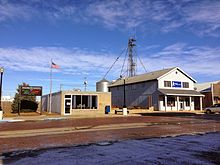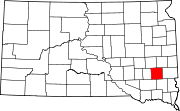City in South Dakota, United States
| Canistota, South Dakota | |
|---|---|
| City | |
 Main Street, Canistota Main Street, Canistota | |
| Nickname: C-Town | |
| Motto: "Home of the Hawks" | |
 Location in McCook County and the state of South Dakota Location in McCook County and the state of South Dakota | |
| Coordinates: 43°35′52″N 97°17′33″W / 43.59778°N 97.29250°W / 43.59778; -97.29250 | |
| Country | United States |
| State | South Dakota |
| County | McCook |
| Established | 1883 |
| Incorporated | 1900 |
| Area | |
| • Total | 0.56 sq mi (1.45 km) |
| • Land | 0.56 sq mi (1.45 km) |
| • Water | 0.00 sq mi (0.00 km) |
| Elevation | 1,549 ft (472 m) |
| Population | |
| • Total | 631 |
| • Density | 1,124.78/sq mi (434.54/km) |
| Time zone | UTC-6 (Central (CST)) |
| • Summer (DST) | UTC-5 (CDT) |
| ZIP code | 57012 |
| Area code | 605 |
| FIPS code | 46-09300 |
| GNIS feature ID | 1267308 |
| Website | City of Canistota, South Dakota |
Canistota is a city in McCook County, South Dakota, United States. The population was 631 at the 2020 census. Canistota is known for chiropractic services, especially the longstanding Ortman Clinic, which attracts many Amish people from around the Midwest.
History

Canistota was named after Canastota, New York the home of a railroad official, but misspelled in the application for a post office. The city was platted in 1883. Its location is the northwest corner of Section 34, chosen by the Chicago Northwestern Railroad. Canistota incorporated in 1900.
Geography
According to the United States Census Bureau, the city has a total area of 0.56 square miles (1.45 km), all land.
Demographics
| Census | Pop. | Note | %± |
|---|---|---|---|
| 1910 | 409 | — | |
| 1920 | 594 | 45.2% | |
| 1930 | 590 | −0.7% | |
| 1940 | 665 | 12.7% | |
| 1950 | 687 | 3.3% | |
| 1960 | 627 | −8.7% | |
| 1970 | 636 | 1.4% | |
| 1980 | 626 | −1.6% | |
| 1990 | 608 | −2.9% | |
| 2000 | 700 | 15.1% | |
| 2010 | 656 | −6.3% | |
| 2020 | 631 | −3.8% | |
| U.S. Decennial Census | |||
2010 census
As of the census of 2010, there were 656 people, 242 households, and 159 families residing in the city. The population density was 1,171.4 inhabitants per square mile (452.3/km). There were 281 housing units at an average density of 501.8 per square mile (193.7/km). The racial makeup of the city was 95.0% White, 2.0% Native American, 0.5% Asian, 0.2% Pacific Islander, 0.9% from other races, and 1.5% from two or more races. Hispanic or Latino of any race were 2.3% of the population.
There were 242 households, of which 30.6% had children under the age of 18 living with them, 52.5% were married couples living together, 8.7% had a female householder with no husband present, 4.5% had a male householder with no wife present, and 34.3% were non-families. 28.5% of all households were made up of individuals, and 13.2% had someone living alone who was 65 years of age or older. The average household size was 2.50 and the average family size was 3.09.
The median age in the city was 43.3 years. 24.8% of residents were under the age of 18; 5.9% were between the ages of 18 and 24; 21.3% were from 25 to 44; 26.7% were from 45 to 64; and 21.3% were 65 years of age or older. The gender makeup of the city was 49.4% male and 50.6% female.
2000 census
As of the census of 2000, there were 700 people, 254 households, and 175 families residing in the city. The population density was 1,248.4 inhabitants per square mile (482.0/km). There were 275 housing units at an average density of 490.4 per square mile (189.3/km). The racial makeup of the city was 97.86% White, 0.86% Native American, 0.29% from other races, and 1.00% from two or more races. Hispanic or Latino of any race were 0.71% of the population.
There were 254 households, out of which 35.0% had children under the age of 18 living with them, 58.3% were married couples living together, 6.7% had a female householder with no husband present, and 31.1% were non-families. 29.5% of all households were made up of individuals, and 18.9% had someone living alone who was 65 years of age or older. The average household size was 2.55 and the average family size was 3.17.
In the city, the population was spread out, with 28.0% under the age of 18, 4.9% from 18 to 24, 26.6% from 25 to 44, 16.3% from 45 to 64, and 24.3% who were 65 years of age or older. The median age was 39 years. For every 100 females, there were 90.2 males. For every 100 females age 18 and over, there were 84.6 males.
The median income for a household in the city was $31,389, and the median income for a family was $39,464. Males had a median income of $30,655 versus $19,000 for females. The per capita income for the city was $14,708. About 8.0% of families and 9.4% of the population were below the poverty line, including 6.2% of those under age 18 and 16.8% of those age 65 or over.
Education

Canistota Public Schools belong to the Canistota School District. The Canistota School District has one elementary school that serves grades kindergarten through sixth grade, and one high school that serves seventh grade through twelfth grade.
Students attend Canistota High School.
Notable people
- Charles Kostboth, legislator in the third South Dakota House of Representatives, homesteader in the early days of Canistota, and leading businessman
References
- "SD Towns" (PDF). South Dakota State Historical Society. Archived from the original (PDF) on February 10, 2010. Retrieved February 11, 2010.
- ^ Canistota: Our Heritage and History. Canistota Clipper. 1984. Retrieved August 27, 2014.
- "ArcGIS REST Services Directory". United States Census Bureau. Retrieved October 15, 2022.
- ^ U.S. Geological Survey Geographic Names Information System: Canistota, South Dakota
- ^ "Census Population API". United States Census Bureau. Retrieved October 15, 2022.
- "U.S. Census Bureau: Canistota city, South Dakota". www.census.gov. United States Census Bureau. Retrieved March 19, 2022.
- Popp, Richard L. (2001). South Dakota, 1900-1930, in Vintage Postcards. Arcadia Publishing. p. 76. ISBN 978-0-7385-1877-0. Retrieved August 29, 2014.
- Hunhoff, Bernie (June 2007). South Dakota Curiosities: Quirky Characters, Roadside Oddities and Other Offbeat Stuff. Globe Pequot Press. p. 23. ISBN 978-0-7627-4336-0. Retrieved August 29, 2014.
- Cayton, Andrew R. L.; Sisson, Richard; Zacher, Chris (November 2006). The American Midwest: An Interpretive Encyclopedia. Indiana University Press. p. 49. ISBN 0-253-00349-0. Retrieved August 29, 2014.
- Brush, Carl and Jan (July 26, 2016). "Pedaling South Dakota: Day Two". South Dakota Magazine. Retrieved July 26, 2016.
- Chicago and North Western Railway Company (1908). A History of the Origin of the Place Names Connected with the Chicago & North Western and Chicago, St. Paul, Minneapolis & Omaha Railways. p. 51.
- "US Gazetteer files 2010". United States Census Bureau. Archived from the original on July 2, 2012. Retrieved June 21, 2012.
- United States Census Bureau. "Census of Population and Housing". Retrieved September 23, 2013.
- "U.S. Census website". United States Census Bureau. Retrieved June 21, 2012.
- "Canistota School District -1". Canistota School District 1. Archived from the original on June 27, 2012. Retrieved July 28, 2012.
External links
| Municipalities and communities of McCook County, South Dakota, United States | ||
|---|---|---|
| County seat: Salem | ||
| Cities |  | |
| CDPs | ||
| Unincorporated community | ||